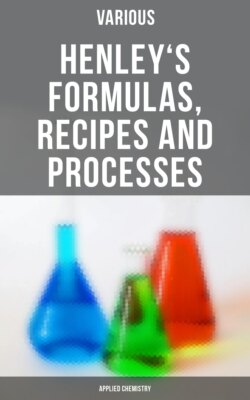Читать книгу Henley's Formulas, Recipes and Processes (Applied Chemistry) - Various - Страница 386
На сайте Литреса книга снята с продажи.
Antiseptic Powders.—
Оглавление| I.— | Borax | 3 ounces |
|---|---|---|
| Dried alum | 3 ounces | |
| Thymol | 22 grains | |
| Eucalyptol | 20 drops | |
| Menthol | 1 1/2 grains | |
| Phenol | 15 grains | |
| Oil of gaultheria | 4 drops | |
| Carmine to give a pink tint. | ||
| II.— | Alum, powdered | 50 parts by weight |
| Borax, powdered | 50 parts by weight | |
| Carbolic acid, crystals | 5 parts by weight | |
| Oil of eucalyptus | 5 parts by weight | |
| Oil of wintergreen | 5 parts by weight | |
| Menthol | 5 parts by weight | |
| Thymol | 5 parts by weight | |
| III.— | Boracic acid | 10 ounces |
| Sodium biborate | 4 ounces | |
| Alum | 1 ounce | |
| Zinc sulphocarbolate | 1 ounce | |
| Thymic acid | 1 drachm. |
Mix thoroughly. For an antiseptic wash dissolve 1 or 2 drachms in a quart of warm water.
IV.—Ektogan is a new dusting powder which is a mixture of zinc hydroxide and dioxide. It is equivalent to about 8 per cent of active oxygen. It is a yellowish-white odorless and tasteless powder, insoluble in water. It is used externally in wounds and in skin diseases as a moist dressing mixed with citric, tartaric, or {99} tannic acid, which causes the liberation of oxygen. With iodides it liberates iodine. It is stated to be strongly antiseptic; it is used in the form of a powder, a gauze, and a plaster.
